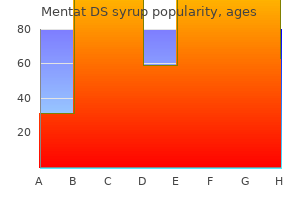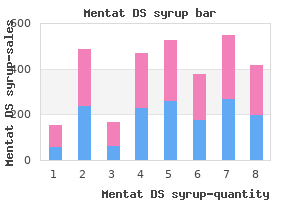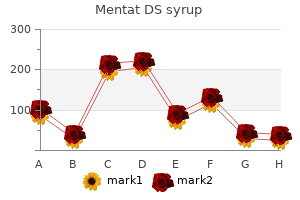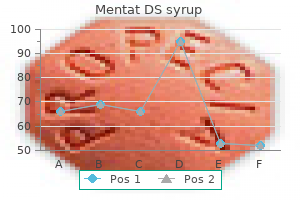"Buy mentat ds syrup master card, symptoms 7 days after ovulation".
By: B. Jared, M.B. B.CH., M.B.B.Ch., Ph.D.
Clinical Director, University of Central Florida College of Medicine
In fact medicine woman purchase mentat ds syrup 100ml with amex, receptors may be synthesized in excess under some conditions symptoms hiatal hernia order mentat ds syrup 100 ml on line, especially if these receptors are blocked by a drug for a long period of time treatment group generic 100ml mentat ds syrup mastercard. Shown here is the blue neurotransmitter cascade leading to second messenger formation medications starting with p cheapest mentat ds syrup, followed by second messenger activation of an intracellular enzyme, which in turn has triggered yet another intracellular enzyme to produce red molecules. Thus, fewer blue neurotransmitter receptors are being formed, as represented by the tortoise on the arrows of neurotransmitter receptor synthesis. Thus, the blue neurotransmitter cascade leads to second messenger formation, which is followed by second messenger activation of an intracellular enzyme, which in turn has triggered yet another intracellular enzyme to produce red molecules. Thus, a greater number of blue neurotransmitter receptors are being formed, as represented by the hare on the arrows of neurotransmitter receptor synthesis. The complicated molecular cascades of Figures 2-43 and 2-44 are shown here with simplified icons. Thus, when fewer neurotransmitter receptors are formed, the process is called down regulation. Thus, a substrate is said to be turned into a product by enzymatic modification of the substrate molecule. The substrate then finds the active site of the enzyme, and binds to it (2), so that a molecular transformation can occur, changing the substrate into the product (3). Exactly this is suspected to be the case for the condition known as tardive dyskinesia (see Chapter 11, antipsychotics), which is apparently caused when drugs that block dopamine receptors cause abnormal changes in the number or sensitivity of dopamine receptors. Shown here is an irreversible inhibitor of an enzyme, depicted as binding to the enzyme with chains. The binding is locked so permanently that such irreversible enzyme inhibition is sometimes called the work of a "suicide inhibitor," since the enzyme essentially commits suicide by binding to the irreversible inhibitor. The enzyme molecule that has bound the irreversible inhibitor is permanently incapable of further enzymatic activity and therefore is essentially "dead. Other drugs are reversible enzyme inhibitors, depicted as binding to the enzyme with a string. It is possible for the inhibitor to be chased off the enzyme under the right circumstances, in which case the inhibition is reversed and the enzyme becomes fully functional again. At each point along the way, there is a potential site of action for psychotropic drugs or for contributions to psychiatric and neurological diseases. Finally, altering the rates of synthesis of enzymes that can either create or destroy neurotransmitters can also affect the amount of chemical neurotransmitter available for neurotransmission and thereby alter the chemical neurotransmission process itself. Enzymes as Sites of Drug Action Enzymes are involved in multiple aspects of chemical neurotransmission, as discussed earlier in this chapter. However, in practice only a minority of currently known drugs are enzyme inhibitors. This reversible enzyme inhibitor is being challenged by the substrate for this same enzyme. In the case of a reversible inhibitor, the molecular properties of the substrate are such that it can get rid of the reversible inhibitor, which is depicted as scissors cutting the string that binds the reversible inhibitor to the enzyme. The enzymes most important in the neurotransmission process are those that make and destroy the neurotransmitters. Thus, precursors are transported into the neuron with the aid of an enzyme-assisted transport pump and converted into neurotransmitters by a series of neurotransmitter-synthesizing enzymes. Once synthesis of the neurotransmitter is complete, it is stored in vesicles, where it stays until released by a nerve impulse. In the vesicle, the neurotransmitter is also protected from enzymes capable of breaking it down. Once released, however, the neurotransmitter is free not only to diffuse to its receptors for synaptic actions but also to diffuse to enzymes capable of destroying the neurotransmitter or to the reuptake pump already discussed above and represented in Figures 2 - 20 through 2-24. Enzyme activity is thus the conversion of one molecule into another, namely a substrate into a product. The substrates for each enzyme are very unique and selective, as are the products. The inhibitors of an enzyme are also very unique and selective for one enzyme as compared with another. Enzymes doing their normal work bind their substrates prior to converting them into products (Fig 2- 46). The consequence of a substrate competing successfully for reversal of enzyme inhibition is that the substrate essentially displaces the inhibitor and shoves it off. Because the substrate has this capability, the inhibition is said to be reversible.

However symptoms 7 days pregnant buy mentat ds syrup with a visa, allosteric modulation is a formula to maximize ionic conductance beyond that which the gatekeeper alone can accomplish symptoms lactose intolerance purchase mentat ds syrup 100 ml line. Thus treatment deep vein thrombosis buy discount mentat ds syrup 100ml line, the gatekeeper can increase ionic conductance through an ion channel much more dramatically when an allosteric modulator is helping than it can when it is working alone medications online order cheap mentat ds syrup online. Rather, a partial agonist acts like a rheostat, or dimming switch, which turns on the light but only partially. Negative Allosteric Interactions An example of negative allosteric modulation is the case of the antidepressants, which act as neurotransmitter reuptake blockers for the neurotransmitters norepinephrine and serotonin. When the neurotransmitters norepinephrine and serotonin bind to their own selective receptor sites, they are normally transported back into the presynaptic neuron, as shown in Figure 2 - 23. However, when certain antidepressants bind to an allosteric site close to the neurotransmitter transporter (represented as an icon in. When no agonist is present, the situation is analogous to the light switch being off. Adding the partial agonist when the lights are off has the effect of turning the lights partially on, to the level preset in the partial agonist rheostat. Thus, in the absence of a full agonist, adding a partial agonist will turn up the lights. An antidepressant drug, which blocks norepinephrine and serotonin reuptake, can be said to modulate in a negative allosteric manner the presynaptic neurotransmitter transporter and thereby block neurotransmitter reuptake. As developed in detail in later chapters, this action may have therapeutic implications for a number of disorders, including depression, panic disorder, and obsessivecompulsive disorder. It should now be clear from these numerous examples that when neurotransmitter receptor binding sites are arranged as neighbors, they can interact with each other allosterically to promote or control some aspect of neurotransmission. This theme is amplified over and over again throughout psychopharmacology, with varying receptors, transmitters, ion channels, and allosteric modifying receptors and their transmitters. It has only been well worked out for a few specific neurotransmitters, for example the benzodiazepine complex, nicotinic cholinergic receptors, and glutamate receptors. However, the most important thing to remember is the concept, not necessarily the details of allosteric modulation. When full agonist is absent, a partial agonist partially opens the ion channel, since it increases the opening relative to the resting state. In this instance, the partial agonist is acting as a net agonist, just as in Figure 3 - H. However, in the presence of full agonist, a partial agonist partially closes the ion channel, since it decreases the opening relative to the open state of the ion channel. In summary, allosteric modulation is a specific concept in which neurotransmitters and their receptors may cooperate with each other to work much more powerfully and through a much greater range of action than they can by themselves. There are at a minimum ion channel sites, neurotransmitter sites, and allosteric sites as targets of drug (and disease) action. However, as a general principle, understanding this architecture of receptor-mediated chemical neurotransmission should provide the reader with the basis to understand a vast array of drug actions, and how such actions modify and impact chemical neurotransmission. Indeed, some systems do incorporate cotransmitters, such as both glutamate and glycine at some glutamate receptor subtypes. In the case of co-transmitters, each can work somewhat independently of the other, and although their effects can be additive if they are working simultaneously, it is not necessary for both to be present for either one to have an effect. The difference is that the neurotransmitter can work in the absence of the allosteric modulator, but the allosteric modulator cannot work in the absence of the neurotransmitter. Thus, these chemicals are not independent of each other and are not considered to be cotransmitters. Summary this chapter has introduced the reader to three special properties of receptors. The first of these is the classification of receptors by their subtypes and by their molecular 98 Essential Psychopharmacology configurations. Also, families of receptors can share common molecular characteristics even if they do not share the same neurotransmitter.

In gentle characters treatment in statistics buy mentat ds syrup 100ml with visa, where devoutness is intense and the intellect feeble medications recalled by the fda generic mentat ds syrup 100 ml without a prescription, we have an imaginative absorption in the love of God to the exclusion of all practical human interests medications for fibromyalgia quality mentat ds syrup 100 ml, which symptoms quit drinking purchase mentat ds syrup with visa, though innocent enough, is too one-sided to be admirable. When the love of God takes possession of such a mind, it expels all human loves and human uses. There is no English name for such a sweet excess of devotion, so I will refer to it as a theopathic condition. Like Saint Philip of Neri in former times, or like Saint Francis Xavier, she said to God: `Hold back, O my God, these torrents which overwhelm me, or else enlarge my capacity for their reception. He thereupon took out her mortal heart, placed it inside of his own and inflamed it, and then replaced it in her breast, adding: "Hitherto thou hast taken the name of my slave, hereafter thou shalt be called the well-beloved disciple of my Sacred Heart. And I promise thee that my Heart will dilate to shed with abundance the influences of its love upon all those who pay to it these honors, or who bring it about that others do the same. Apparently little else but sufferings and prayers and absences of mind and swoons and ecstasies. They tried her in the kitchen, but were forced to give it up as hopeless-everything dropped out of her hands. The admirable humility with which she made amends for her clumsiness could not prevent this from being prejudicial to the order and regularity which must always reign in a community. They put her in the school, where the little girls cherished her, and cut pieces out of her clothes [for relics] as if she were already a saint, but where she was too absorbed inwardly to pay the necessary attention. Poor dear sister, even less after her visions than before them was she a denizen of earth, and they had to leave her in her heaven. Amiable and good, but so feeble of intellectual outlook that it would be too much to ask of us, with our Protestant and modern education, to feel anything but indulgent pity for the kind of saintship which she embodies. Assurances of his love, intimacies and caresses and compliments of the most absurd and puerile sort, addressed by Christ to Gertrude as an individual, form the tissue of this paltry-minded recital. What with science, idealism, and democracy, our own imagination has grown to need a God of an entirely different temperament from that Being interested exclusively in dealing out personal favors, with whom our ancestors were so contented. Smitten as we are with the vision of social righteousness, a God indifferent to everything but adulation, and full of partiality for his individual favorites, lacks an essential element of largeness; and even the best professional sainthood of former centuries, pent in as it is to such a conception, seems to us curiously shallow and unedifying. After having gently breathed them in, He arose, and said with a gratified air to the Saints, as if contented with ebooks. And the Father took such delight in this soul thus presented by His only son, that, as if unable longer to restrain Himself, He gave her, and the Holy Ghost gave her also, the sanctity attributed to each by His own Sanctus-and thus she remained endowed with the plenary fullness of the blessing of Sanctity, bestowed on her by Omnipotence, by Wisdom, and by Love. Take Saint Teresa, for example, one of the ablest women, in many respects, of whose life we have the record. She wrote admirable descriptive psychology, possessed a will equal to any emergency, great talent for politics and business, a buoyant disposition, and a first-rate literary style. She was tenaciously aspiring, and put her whole life at the service of her religious ideals. Yet so paltry were these, according to our present way of thinking, that (although I know that others have been moved differently) I confess that my only feeling in reading her has been pity that so much vitality of soul should have found such poor employment. In spite of the sufferings which she endured, there is a curious flavor of superficiality about her genius. Jordan, has divided the human race into two types, whom he calls "shrews" and "nonshrews" respectively. Saint Teresa, paradoxical as such a judgment may sound, was a typical shrew, in this sense of the term. Not only must she receive unheardof personal favors and spiritual graces from her Saviour, but she must immediately write about them and exploiter them professionally, and use her expertness to give instruction to those less privileged. Her voluble egotism; her sense, not of radical bad being, as the really contrite ebooks. We have to pass a similar judgment on the whole notion of saintship based on merits. Any God who, on the one hand, can care to keep a pedantically minute account of individual shortcomings, and on the other can feel such partialities, and load particular creatures with such insipid marks of favor, is too small-minded a God for our credence. So much for mere devotion, divorced from the intellectual conceptions which might guide it towards bearing useful human fruit.


Beta-blockers should not be given to patients who have incipient ventricular failure treatment endometriosis purchase mentat ds syrup without a prescription, second- or third-degree atrioventricular block symptoms kidney disease buy discount mentat ds syrup line, or peripheral vascular disease medicine dictionary discount 100ml mentat ds syrup visa. Beta-blockers can produce hyperglycaemia or they can enhance the hypoglycaemic effect of insulin and may precipitate hypoglycaemia treatment xerostomia cheap 100 ml mentat ds syrup amex. Calcium-channel blockers A long-acting dihydropyridine calcium-channel blocker (such as amlodipine, usual dose, 5 mg once daily, section 12. For those in whom a beta-blocker is inappropriate, verapamil may be given as an alternative to treat stable angina. Calcium-channel blockers interfere with the inward movement of calcium ions through the slow channels in heart and vascular smooth muscle cell membranes, leading to relaxation of vascular smooth muscle. Myocardial contractility may be reduced, the formation and propagation of electrical impulses within the heart may be depressed and coronary or systemic vascular tone may be diminished. Calcium-channel blockers are used to improve exercise tolerance in patients with chronic stable angina due to coronary atherosclerosis or with abnormally small coronary arteries and limited vasodilator reserve. Calcium-channel blockers can also be used in patients with unstable angina with a vasospastic origin, such as Prinzmetal angina, and in patients in whom alterations in cardiac tone may influence the angina threshold. Unstable angina Unstable angina requires prompt aggressive treatment to prevent progression to myocardial infarction. Cardiovascular medicines Initial treatment is with acetylsalicylic acid to inhibit platelet aggregation, followed by heparin (section 10. Nitrates and beta-blockers are given to relieve ischaemia; if beta-blockers are contraindicated, verapamil is an alternative, provided left ventricular function is adequate (see also section 12. Prinzmetal angina Treatment is similar to that for unstable angina, except that a calcium-channel blocker is used instead of a beta-blocker. Contraindications: history of asthma or bronchospasm (unless no alternative, in which case use with extreme caution and under specialist supervision); uncontrolled heart failure, Prinzmetal angina, marked bradycardia, hypotension, sick sinus syndrome, second- and third-degree atrioventricular block, cardiogenic shock; metabolic acidosis; severe peripheral arterial disease; phaeochromocytoma (unless used with an alpha-blocker). Precautions: avoid abrupt withdrawal especially in ischaemic heart disease; history of obstructive airway disease (use with caution and monitor lung function (see also Contraindications above); pregnancy (Appendix 2) and breastfeeding (Appendix 3); first-degree atrioventricular block; portal hypertension (liver function deteriorates); renal impairment (reduce dose; Appendix 4); diabetes mellitus (small decrease in glucose tolerance, which can mask symptoms of hypoglycaemia); history of hypersensitivity [increased reaction to allergens, also reduced response to epinephrine (adrenaline)]; myasthenia gravis; interactions: Appendix 1. Cardiovascular medicines exacerbation of intermittent claudication and Raynaud phenomenon; bronchospasm; bradycardia, heart failure, conduction disorders, hypotension; sleep disturbances including nightmares; depression, confusion; hypoglycaemia or hyperglycaemia; exacerbation of psoriasis; rash, dry eyes, and oculomucocutaneous syndrome (reversible on withdrawal) rarely reported. They should therefore be dispensed in glass or stainless steel containers, and closed with a foil-lined cap which contains no wadding. No more than 100 tablets should be dispensed at one time, and any unused tablets should be discarded 8 weeks after opening the container. Contraindications: hypersensitivity to nitrates; hypotension; hypovolaemia; hypertrophic obstructive cardiomyopathy, aortic stenosis, cardiac tamponade, constrictive pericarditis, mitral stenosis; marked anaemia; head trauma; cerebral haemorrhage; angle-closure glaucoma. Precautions: severe hepatic impairment (Appendix 5); renal impairment (Appendix 4); hypothyroidism; malnutrition; hypothermia; recent history of myocardial infarction; interactions: Appendix 1. Patients taking isosorbide dinitrate for the long-term management of angina may often develop tolerance to the antianginal effect; this can be avoided by giving the second of 2 daily doses of longer-acting oral presentations after an 8-hour rather than a 12-hour interval, thus ensuring a nitrate-free interval each day. Adverse effects: throbbing headache; flushing; dizziness, postural hypotension; tachycardia; paradoxical bradycardia also reported. Contraindications: hypotension, bradycardia, second- and third-degree atrioventricular block, sinoatrial block, sick sinus syndrome; cardiogenic shock; history of heart failure or significantly impaired left ventricular function (even if controlled by therapy); atrial flutter or fibrillation complicating Wolff-Parkinson-White syndrome; porphyria. Precautions: first-degree atrioventricular block; acute phase of myocardial infarction (avoid if bradycardia, hypotension, or left ventricular failure present); hepatic impairment (Appendix 5); children (specialist advice only); pregnancy (Appendix 2) and breastfeeding (Appendix 3); avoid grapefruit juice (may affect metabolism); interactions: Appendix 1. Adverse effects: constipation; less commonly nausea, vomiting, flushing, headache, dizziness, fatigue, and ankle oedema; rarely allergic reactions including pruritus, urticaria, angioedema, and erythema multiforme (Stevens-Johnson syndrome); myalgia, arthralgia, paraesthesia, erythromelalgia; increased prolactin concentration; gynaecomastia and gingival hyperplasia on long-term treatment; hypotension, heart failure, bradycardia, heart block, and asystole (due to negative inotropic effect) with high doses. Antiarrhythmics must be used cautiously since most drugs that are effective in treating arrhythmias can provoke them in some circumstances; this arrhythmogenic effect is often enhanced by hypokalaemia. When antiarrhythmic drugs are used in combination, their cumulative negative inotropic effects may be significant, particularly if myocardial function is impaired. Atrial fibrillation the increased ventricular rate in atrial fibrillation can be controlled with a betaadrenoceptor antagonist (beta-blocker) such as atenolol (section 12. Digoxin, a cardiac glycoside, slows the ventricular response and is particularly appropriate if atrial fibrillation is accompanied by congestive heart failure (see also section 12. Intravenous digoxin is rarely of value for rapid control of the ventricular rate because response may take many hours. If adequate control at rest or during exercise cannot be achieved readily verapamil may be introduced with digoxin, but it should be used with caution if ventricular function is impaired. Anticoagulants are indicated especially in valvular or myocardial disease, and in the elderly. If atrial fibrillation began within the previous 48 hours, and there does not appear to be a danger of thromboembolism, antiarrhythmic drugs, such as procainamide or quinidine, may be used to terminate the fibrillation or to maintain sinus rhythm after cardioversion.
Cheap mentat ds syrup. Klonopin Withdrawal Symptoms Xanax Withdrawal Symptoms Cure.


